Expanding Your Training with Kettlebells, Exercise Bands, and Chains
Adam T Glass, SSgt, USAF
May 14, 2008 02:52 PM
Recently I have been achieving new PR's in many of my lifts, especially my grip and pressing strength. I attribute this new found power to three things.
1) Sticking to the fundamental drills and staying on track with them (the one arm military press, the swing, pistol, and row)
2) Developing my short bending abilities. Steel bending is the best strengthener of the wrist and hands, as well as a powerful upper body work out.
3) Using jump stretch bands, chains, boards and a few other implements to create some unusual awkward variation of the above listed drills.
With the following items, I have assembled an equipment setup, which has cost me under $500 dollars. This kit rivals most fitness centers I have been in. It is a compact, easily transported total body gym.
- Russian Kettlebell, most people only need one 53 pound weight. Lighter weights, such as a 36 or 44 will do.
- Jump Stretch bands. I have a complete set of mini's, monster mini's, light, average, strong, and monster. At a minimum, get one light, one average and a set of mini's.
- A piece of 2x4. I keep an 18-inch board with a hole drilled center mass. I attached a piece of 550 cord to make a loop and attached a D-ring to it.
- A length of chain, 5-7 feet long. I do not know the exact weights of pieces of chain of certain diameters, but the piece I have is 1/2" thick and 7 feet long. Chain is outstanding because it increases the weight as the range of motion lengthens. This particular piece weighs in at 28 pounds.
- Iron Mind Rolling Thunder deadlifting handle. This is an outstanding implement. Take a RT, a D-ring, and a jump stretch band. You now have a thick handled weight. A crafty person could construct something similar with PVC.
All of this together is inexpensive and will fit in to one medium sized duffle bag (minus the K-bell) I carry the kettle bell in a rucksack.
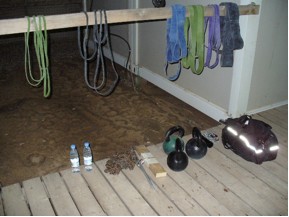 Complete gym set as described in the above paragraph
Complete gym set as described in the above paragraphThe first set of drills I recommend can be found in the Diesel Crews "Advanced kettlebell techniques" article, in which they detail using a jump stretch band and a kettlebell for swings, dead lifts, rows and presses. Simply choke the band around the handle and you are in business. Refer to the article for exact details.
THE BAND RACKA technique I have added recently is using the jump stretch bands to add more weight to my body for other drills. It feels like you have a bar racked across your shoulders. I have found I can press more weight with the bands on because I am loading more tension before I begin the drill. The effect is the same for grip techniques. To do it, simply put a band on each shoulder and cross them in front of your body. Step on the ends. Now go ahead and perform your drills.
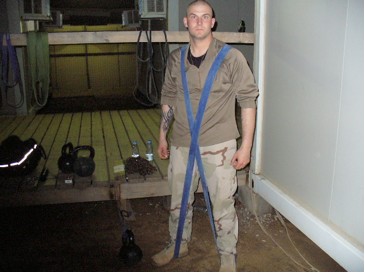 Basic band rack position, shown with two strong JS bands
Basic band rack position, shown with two strong JS bandsTo further increase the total tension, you can double loop a mini band around your upper legs. This will force you to shove your feet in to the ground, and keep your hips solid and forward during your presses and pulls.
Add these elements together for swings, and you have an extremely explosive drill. Take a light jump stretch and choke it to the handle of the KB. Now use a D-ring on the other and attach it to a pole or something very solid. Put the jump stretch bands on your shoulders. Now perform your swings as usual. You will have explosively drive with the hips and shove your heels in to the ground. The band will rip the bell back at the top, making the movement very fast. The cardio element is amplified, as well as the core and grip element.
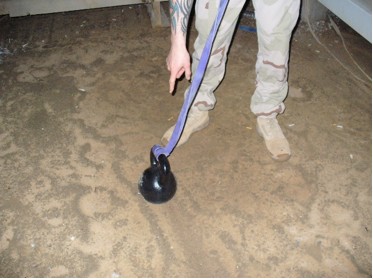
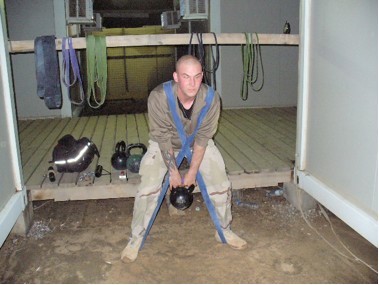 Band swing with band rack, the camera was too slow to catch the top position
Band swing with band rack, the camera was too slow to catch the top positionYou can do the exact same thing with presses.
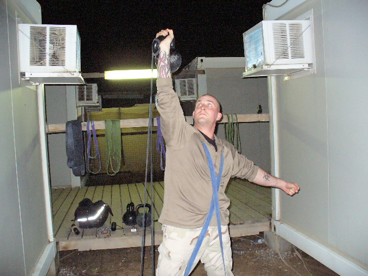 Band rack press shown with a 53lbs kettlebell and a monster mini band
Band rack press shown with a 53lbs kettlebell and a monster mini bandFor the row, it is not exactly a bent over row, as the pull is mostly horizontal. The movement is superior to the bent over row because of the functionality. You are pulling against a weight that pulls back, plus the weight of the bands pulling you down. One word of caution is to keep your reps low because your back will fatigue quickly. I use a KB for a handle, the board for pinch rows, and the RT handle for one arm rows.
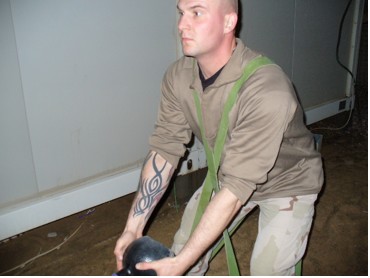 Band rack row bottom position
Band rack row bottom position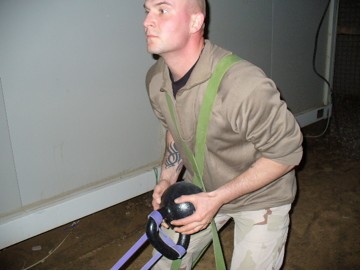 Band rack row top positionMODIFIED CRUSH LIFT:
Band rack row top positionMODIFIED CRUSH LIFT: This is a powerful drill. You will take a kettlebell and clip a chain on to the handle and attach it to either another kettlebell or to a band. Put the bands on your shoulder, squat down and crush the bell side of the KB. As you stand up, you will lift the other bell, and it will move around. There is huge core work here, along with the chest, arms, shoulders, upper back, and lower back. Try it and you will love this one.
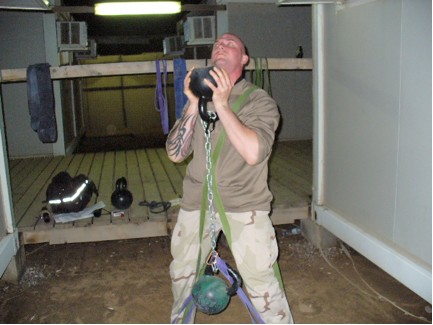 Modified crush lift shown with two average JS bands racked two 62lbs bells, and a light JS on the bottom of the bell.ACHIEVING THE TACTICAL PULL UP, WITH JS BANDS:
Modified crush lift shown with two average JS bands racked two 62lbs bells, and a light JS on the bottom of the bell.ACHIEVING THE TACTICAL PULL UP, WITH JS BANDS:EASIER: The key to learning any drill is starting off with a weight which you can control. The tactical pull up is a dead hang start, with a thumbless overhand grip, using no kipping or body english to complete the rep. At the top of the rep you pause and touch your throat or chest to the bar. This drill builds unreal pulling strength. It is very difficult for beginners to learn. A simple solution is to throw a jump stretch band over the bar and use it to make the start easier. As you get stronger use weaker bands until you do not need them.
HARDER: Tie the band off on something in the floor. Connect it to your belt. You will have really rip your self up to the bar and outrun the band. Hold yourself up at the top for a moment. Great drill for the grip.
CHAINS:Chains are awesome. A lot of people are familiar with the Powerlifting applications of chains for the bench press, dead lift and squat. I am going to throw in some ideas for some other drills. Chains add variable resistance, but in a different fashion then bands. Bands require explosive technique, and will pull back at different angles depending on where you hook them. Chains will follow the path of gravity. As the implement is lifted, the chain gets heavier as more links are pulled off the ground. This allows for a heavier final position then the start. Here are a few drills where the chain really shines.
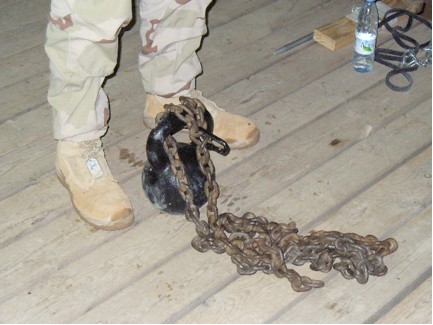
Chain Pistol-body weight: Most people can not do body weight pistols because they need a counter balance to get to the low position with out falling. The chain will be heavy enough at the top to allow you pull yourself down with out falling. At the bottom there will be very little weight. I have used this drill, along with the graduated method to move towards body weight pistols.
Chain Pistol-with weight: An alternative direction is to attach the chain to the implement as increased resistance to make the pistols harder. I prefer a kettlebell as the primary weight for resistance pistols because the handle's shape. By attaching a chain, it is harder on ascent as the weight increases with every half inch. Combine this with a slow tempo and it is a killer drill.
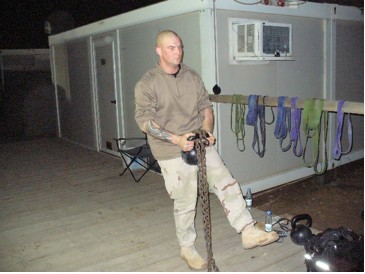 Top position of the chain pistol, use a slow tempo to take advantage of the chain
Top position of the chain pistol, use a slow tempo to take advantage of the chainChain Get-Ups: The get up is the drill of choice for strong healthy shoulders and core. A problem some people have is making the jumps in weight kettlebells come in. Others have problems because we do not have bells heavy enough. Chains offer a solution to both problems. Use a chain and attach it to the handle with a D-ring. Now do your get up. Just make sure you don't get moving too fast and hit yourself with the chain as you stand up. (I wouldn't say it if I haven't seen it)
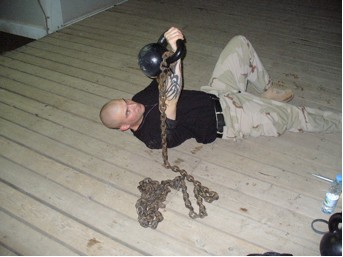
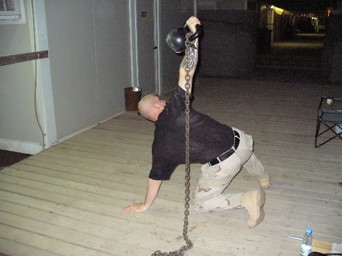
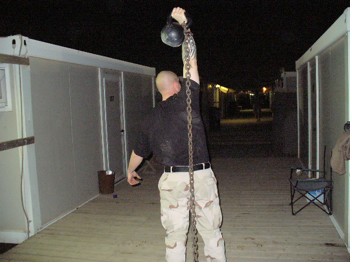
Chain Tactical Pull-ups: We all are familiar with weighted pull ups, this is a simple variation. Any belt will do, I just use my DCU rigger belt. This can assist you as you make jumps in weight.
Chain Turkish Press: A Turkish press is one were you sit on your butt with your legs in front of you. You cross your feet at the ankle. Unlike the seated press, you can not lean back in to a bench or move your spine to a compromising position. With a given weight, it is harder to Turkish press then it is to stand and press. You simply attach the chain and press.
Chain and Band-One Arm RT DL: I don't have a loading pin here. And if I did, it wouldn't matter because I don't have plates. But that is not stopping me from building my support grip. I take a jump stretch band and run it through the handle of the KB. I then stand on the ends of the band. I chain the handle of the KB to the RT. I have no idea how much weight this equals out to, but it is a very taxing grip exercise. I must pull harder to "outrun" the band.
RT Band Press: This is close to the feeling of the KB press, as you can lever the band off your forearm during the press. Simply choke a band on the RT handle, step on the other end and press.
I hope I have shared some new ideas with you on this. My favorite element of these implements is having the ability to use a lot of resistance without having to own a lot of weight. Like I stated earlier, my whole "gym" fits in to one medium sized gym bag. Don't get tied to the gym! I will keep innovating with bands and chains; I will continue to eliminate weakness. No matter where I am in the world, I stay strong.
Adam T Glass, SSgt, USAF is a Security Forces Craftsman. He competes in arm wrestling, strongman and Greco-roman wrestling. Feel free to contact him at hardstyle5555@yahoo.com
Back